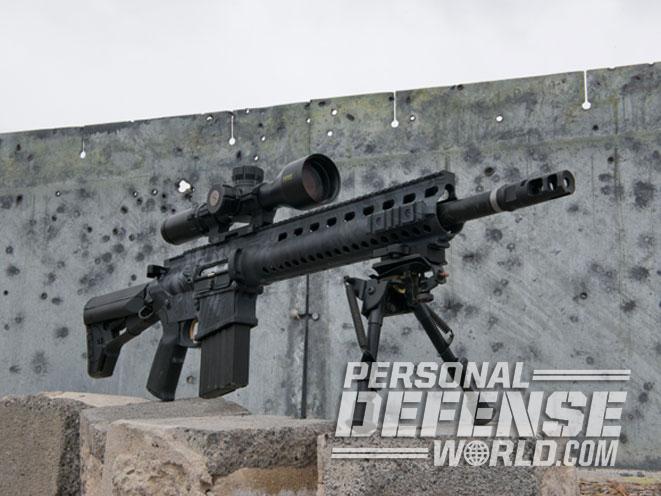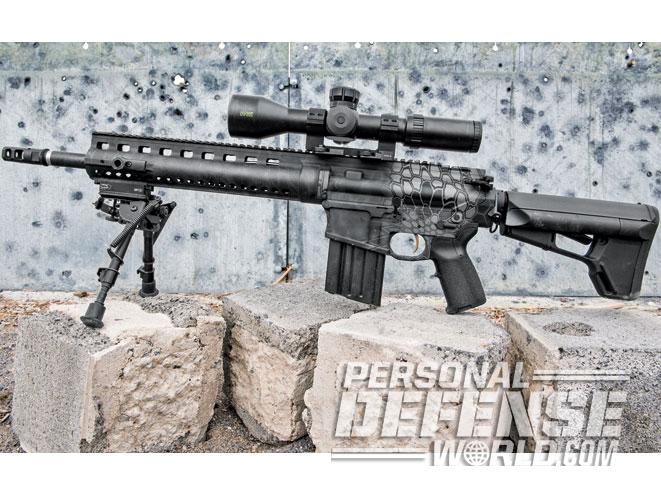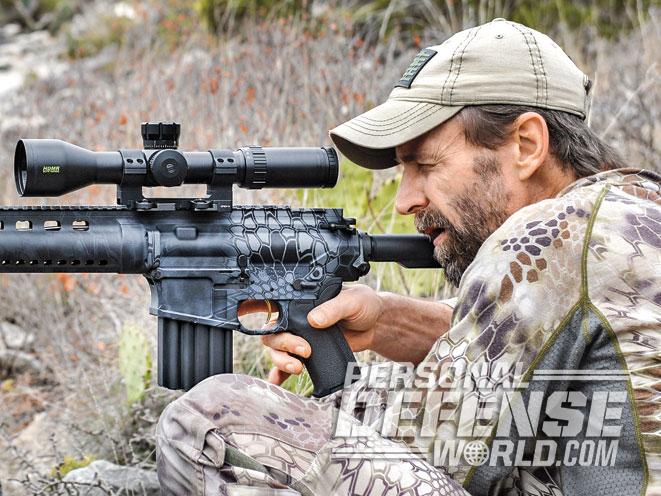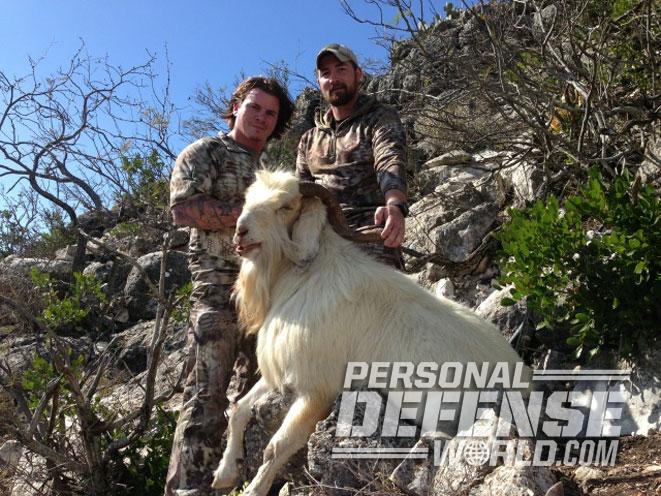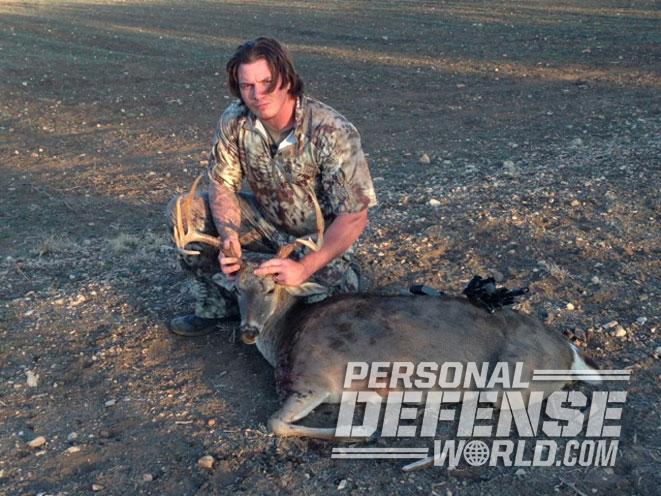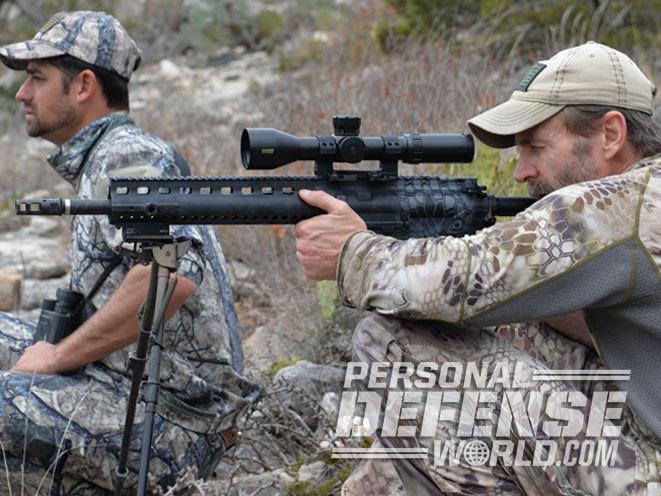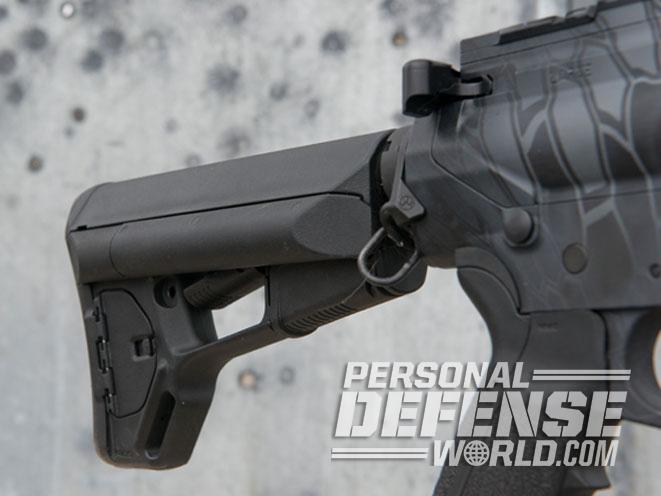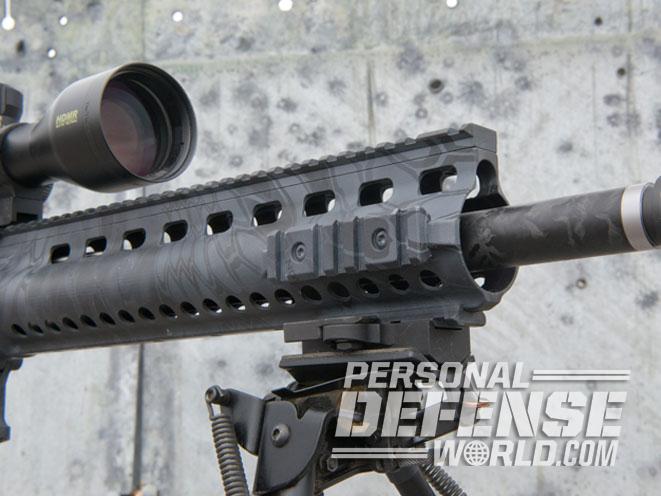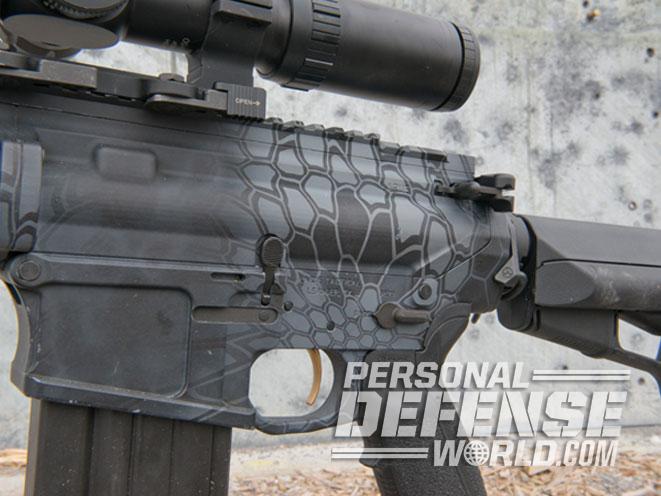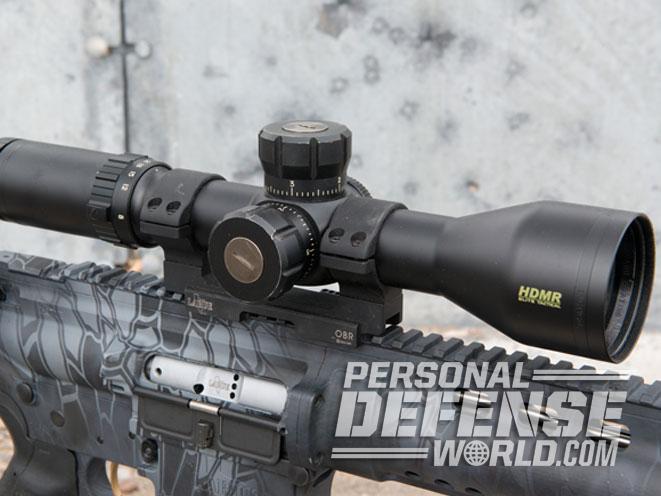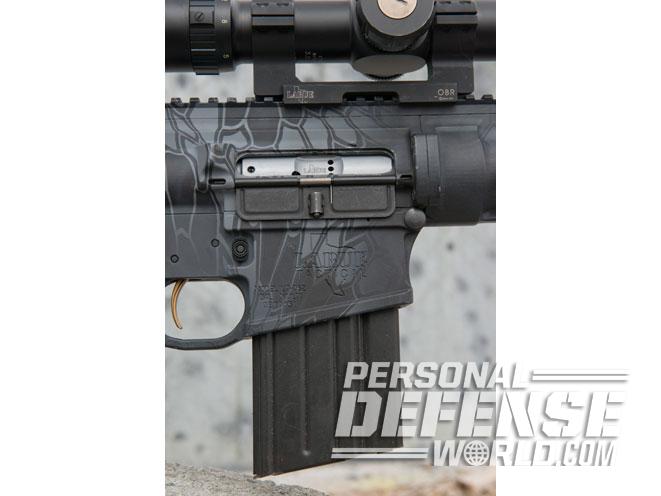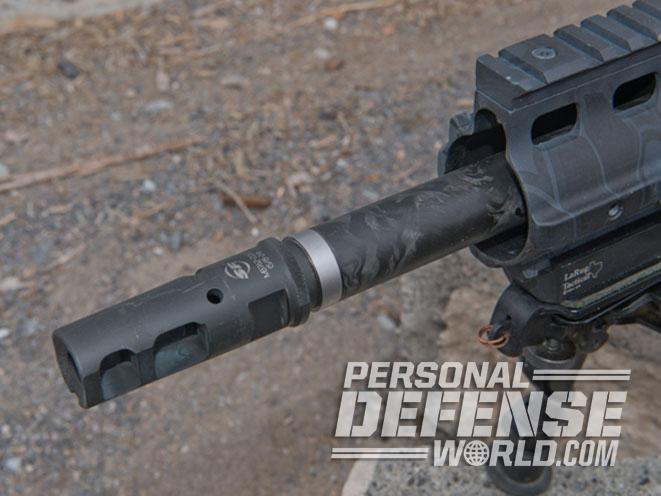LaRue Tactical of Leander, Texas, known for its durable and precision-machined parts, took to task the challenge of creating a 7.62mm rifle that could be both accurate at distance and reliable in the field. Today, the 7.62mm OBR finds itself as an established standard, and it was brought back to Texas with a carbon-fiber-wrapped barrel from Proof Research and put it in the hands of one of America’s most battle-tested warriors for a Texas Hill Country sheep hunt.
Optimizing The OBR
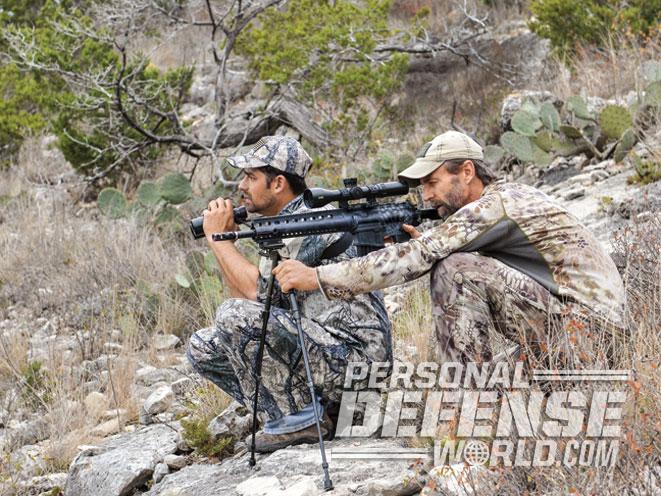
The performance of LaRue’s OBR can be largely attributed to two design features: a beefier but precisely milled upper receiver and bolt-carrier group, and a true, free-floating barrel.
Advertisement — Continue Reading Below
LaRue’s approach ensures a solid and consistent seating of the cartridge by components that can handle the increased dynamic stress of the larger round. Once fired, the round travels through a barrel not subject to the typical torque of an AR’s handguard from a bipod or sling. The result is a rifle that shoots sub-MOA groups but can endure the rigors of field duty.
The OBR used for this hunt is unique, as Proof Research added a carbon-fiber-wrapped barrel with a match-grade, precision-cut steel core to the basic platform. Designed for strength, consistency and weight savings, the Proof barrel dialed-in a best three-shot group of 0.38 MOA with Black Hills 175-grain OTM cartridges. Carbon fiber is 14 percent stiffer than steel and seven times stronger by weight. A Proof carbon-fiber AR barrel can weigh up to 27 percent less, and a hunting rifle barrel as much as 40 percent less. But the strength and rigidity of the barrel is where Proof truly adds to the performance. Harmonic interference is significantly reduced and heat dissipation is dramatically increased. The result is a barrel that delivers consistent groups through sustained use.
RELATED STORY: AR Must-Have – LaRue Tactical’s MBT-2S Trigger
Advertisement — Continue Reading Below
Additionally, the rifle was given a Kryptek Typhon Cerakote finish hand-painted by MCM Firearms of Idaho. Not a hydro-dip, MCM Firearms custom finishes their rifles using a combination of stencils and an airbrush. “Cerakote is a rugged product that has become a standard in our industry for those who want their finishes to hold up. We worked hard to get the 3D effect of the Kryptek Typhon pattern and a shadowing fade from the action to the barrel. It required a combination of techniques, but it turned out nicely,” said MCM Firearms.
For the optic, we ran a Bushnell Elite HDMR 3.5-21x50mm scope on a LaRue Tactical QDR mount. The final addition to the LaRue OBR rifle was a Harris tactical bipod.
It’s not often a gun writer gets to spend time in the field with a man like Tom Spooner. A warrior with an almost mythic resume, Tom continues to serve after retiring in 2010 as a master sergeant from a 21-year career that included more than 40 months of direct-action combat in his 15 years as a member of the Army’s elite Special Operations Detachment-Delta. Today, Tom and fellow Special Forces veteran J.D. Potynsky train the next generation of soldiers and law enforcement officers in combat shooting and tactics based upon their hard-won combat lessons. Not without his own internal struggles and scars from his time on the battlefield, Tom is also the vice president of Elder Heart, a veteran’s support organization that rehabilitates veterans with PTSD and TBI through local public art projects.
Advertisement — Continue Reading Below
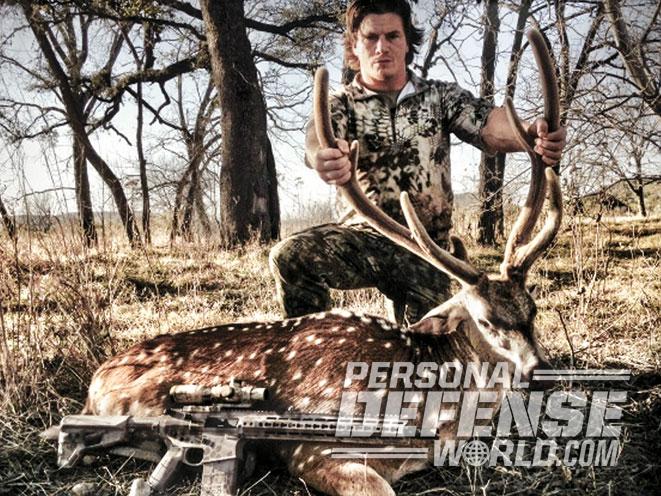
Still lean and ropy, Tom is soft-spoken with an easy smile that belies a precise intensity that snaps to the front when some matter of importance or focus is at hand. His relaxed but measured movement across the crags and rocks of Texas are still not without the wary balance developed over years in foreign territory. As we climbed and navigated the escarpments of the Texas Hill Country, Tom seemed to visibly relax and look back to smile more frequently. I asked him about it. He replied, “Though I hunted growing up, through all those years on active duty, I didn’t get to do much of this. It’s taken me just a little while to adjust to the fact that no one is going to be shooting at us. It’s nice.”
J.D. Potynsky is Spooner’s partner in their Northern Red training business. Also in the hunting party was Butch Whiting, Josh Cleghorn and Camp Bailey of Kryptek. Potynsky was also hunting with a 7.62mm LaRue OBR, but with a standard 16-inch, steel barrel. The Hill Country was familiar to Whiting, Cleghorn and Bailey. So it was not without some surprise to everyone that Potynsky, the guy from New Jersey, would prove the most productive hunter of the group.
RELATED STORY: LaRue Tactical PredatAR 5.56mm
Advertisement — Continue Reading Below
The Texas Hill Country is mostly limestone and granite with sections of caliche rock that crop up and frame the various rivers and streams of the area. Under the surface, caves and springs exist that can manifest in a sinkhole or a small pond with no inlet or outlet. The surfaces of the hills, which are really small cliffs, are particularly suited for four-legged, hard-hoofed animals. Nothing is flat, and the surface is littered with the constantly cracking and sliding limestone that can announce a single false step for hundreds of yards. The sheep here are not to be confused with the wooly, group-thinking variety. Wild sheep are smart, cagey and agile. When they are spooked, they don’t get curious—they put a terrain feature between themselves and a perceived threat. In the case of humans, red sheep seem particularly aware of how far they need to go to put an hour’s walk between themselves and a rifle. Scrub live oak and prickly pear cactus are thick throughout the area, and the sheep never seem to be more than two steps away from concealment. The only advantage we had was fantastic weather. Highs were in the low 80s under a mostly overcast sky in late February—ideal for walking the dry and steep country—and there would no shortage of that.
Chris Walker, a Texan and biologist, guided us up the valleys and draws after the sheep. Typically, the sheep descend the rocky, scrub-covered hills and feed in the middle elevations down to the bases. They know their strengths and tend to stay off the flat land, sticking to terrain where everyone but them slows to almost a crawl. We glassed and stalked through long stretches of scrub live oak, slowly winding our way higher up the incline. We found signs and tracks, but little else. The red sheep used this country, but not where we were that day. Our methodical ascent provided several excellent points to glass the adjacent hillsides. After several hours, we made it to the top of a long ridgeline that overlooked the Nueces Valley, but still there were no sheep. We traveled slowly along the spine and stopped to glass. Chris picked up some aoudad ewes across a wide bowl, but there were no rams in the group.
Red Sheep In Range
Advertisement — Continue Reading Below
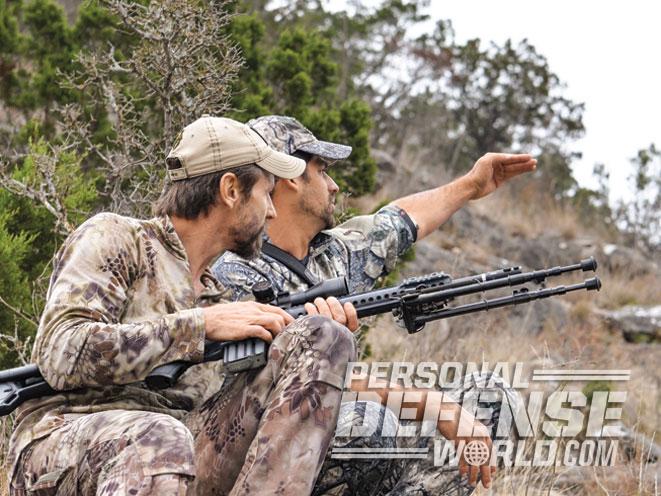
We continued along the ridgeline, glassing the fingers that drop down into thick, scrub-covered valleys. Chris pulled up short and crouched slowly, simultaneously bringing his binoculars to his eyes. He spotted a small group of red sheep several hundred yards ahead. We crept up into a slightly more level position to get a closer look. They were on a ridgeline that cut 90 degrees to the right from the spine we had been following for the past several hours. They were just below the crest in a copse of scrub cedars. A few ewes were in the open, moving from rock to rock, feeding lazily. Then Chris spotted a beautiful ram. He was either lying down or standing and we could only see a ray of sun hitting his back and the curve of one of his horns glowing yellow in the light. He was there, but he wasn’t in a hurry or alerted.
We ranged the ram at 233 yards and waited. If he stood up or took one step forward, Spooner would turn his lights out. He was set up with the OBR in a seated position, with his back against a rock and the long, three-piece Harris bipod extended. The ram gave us a lovely opportunity to take in the Texas scenery that spread out below us. The Nueces River snaked to our west, and the mountains took on varying shades as the sun moved across the horizon, but the ram never moved. The range was the same, ram was the same, the shot was the same. This was sheep hunting. These sheep can stay so still and blend so well with their surroundings that you have to visually mark a terrain feature and memorize the direction and distance to the animals or you’ll lose them.
RELATED STORY: Hog Wild – Wilson Combat-Style Hog Hunting
Advertisement — Continue Reading Below
Finally, the ram won the standoff and Chris decided to flank around behind the hillside and see if there was an angle for a shot. Knowing the ram might move, Tom was at the ready to either move or take the shot. After a short wait, Chris was in position, and one of the ewes had spotted him. Knowing they were alerted, we whistled, hoping the ram would step or stand. The ram, of course, did the one thing we weren’t prepared for: He moved neither left nor right, but ran vertically, in what seemed like zero to full speed, straight up and over the crest of the hill.
He was visible for just over a full second and then was gone with his ewes. He won that round, and the aches of sitting on small limestone boulders suddenly reminded us how long we had waited. The setting sun was a consolation, but only that.
J.D. Potynsky, the occasional hunter from New Jersey, bagged an Axis deer, a Spanish goat, and a 10-point whitetail that oddly ran into a tree and knocked both of its antlers off after taking a 168-grain Black Hills/Barnes TSX round from his OBR. Not a lot was said back at the skinning shed about the guy from Jersey running the table. The Texans are still trying to make sense of it.
Advertisement — Continue Reading Below
FOR MORE INFORMATION
Bushnell
http://www.bushnell.com; 800-423-3537
Kryptek
http://www.kryptek.com
Advertisement — Continue Reading Below
LaRue Tactical
http://www.laruetactical.com; 512-259-1585
MCM Firearms
http://www.mcmfirearms.com; 208-284-4883
Proof Research
http://www.proofresearch.com; 406-756-9290
